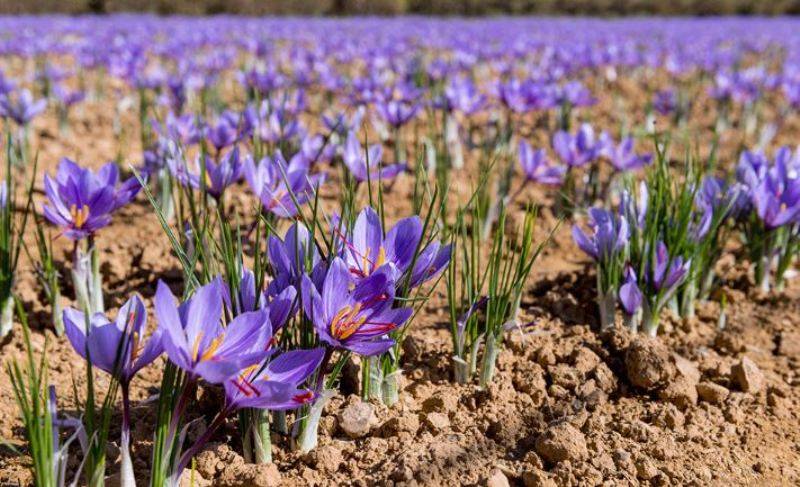
Introduction
Saffron is the most valuable plant in the planet. Because it is so valuable, it is sometimes known as red gold. Saffron cultivation is simple and easy. The cultivation of saffron does not necessitate a lot of effort. Its harvest cycle is also 3 - 4 months, and it can reach a height of 15-20 cm. Its prices are also rising on a daily basis, allowing farmers to make a big profit.
Wild saffron is botanically known as Crocus cartwrightianus. The commercially cultivated saffron is botanically called Crocus sativus.
Uses of Saffron
-
In milk and milk desserts, saffron is used as a flavour and coluring component.
-
It's used as season cheese, mayonnaise, and meat, among other things.
-
In Mughlai cuisine, they are utilized as a flavoring and seasoning agent.
-
It is used to treat arthritis, infertility, liver enlargement, and fever in Ayurveda.
-
It's a common ingredient in perfumes and cosmetics.
Major Saffron Production states in India
Jammu & Kashmir and Himachal Pradesh are the two most important producing states. Kesar in Hindi, Kong in Kashmiri, Jafran in Bengali, Zafran in Punjabi, Keshar in Gujarati, Zafran in Urdu, Asra, Aruna, Asrika, Kunkuma in Sanskrit are some of the native names.
Ideal Conditions for Saffron Cultivation
The most basic condition for commercial saffron production is fertile soil. The second major factor is the climate. It necessitates a long photoperiod and a dry, moist soil.
Climate for Saffron Cultivation
Saffron is grown primarily in sunken and dry places with elevations ranging from 1500 to 2500 metres above sea level. It requires a 12-hour photoperiod, which has several advantages but also slows down the flowering process.
Season for Saffron Farming
-
Saffron Corms are grown in India between the months of June and July, as well as August and September in some areas.
-
In October, it begins to flower.
-
In the summer, it requires intense heat and dryness, while in the winter, it requires extreme cold.
-
Winters in areas of Karnataka, Himachal Pradesh, and Jammu & Kashmir provide the best conditions for development.
Soil for Saffron Farming
One of the most important aspects of saffron growing is the soil. It thrives on loamy, sandy, and calcareous soils. A gravelly soil is also excellent for saffron farming, however a heavy, clayey soil is not.
Saffron grows best on acidic soil. It thrives well when pH of soil is around 5.5 to 8.5.
Water Requirement
Saffron requires less water than other spices. The soil should be slightly damp but not completely dry. Irrigation is done on a weekly basis and 283 m cubic per acre of water must be delivered during the cultivation period.
Planting Material for Saffron Farming
Saffron cultivation is done through corms that are underground compressed stems. There are three varieties of saffron cultivated in India, especially in Kashmir and they are:-
-
Aquilla Saffron
-
Creme Saffron
-
Lacha Saffron
Land Preparation for Saffron Cultivation in India
Make the soil brittle before ploughing or planting saffron seeds by ploughing the land thoroughly. Put 20 tonnes of cow dung, 90 kg of nitrogen, 60 kg of phosphorus, and 60 kg of potassium per hectare on your field before final ploughing, and plough it thoroughly. Your soil will remain fertile and rugged as a result, and your saffron crop will be excellent.
Planting of Saffron Plant
-
Pits of 12-15 cm depth are dug, with an inter-plant interval of roughly 10 cm.
-
Saffron corms are planted straight into the dug trenches for cultivation.
-
The soil is then applied loosely on the surface.
-
If you do not pack compactly, air circulation may be restricted.
-
Irrigation is not required after sowing the corms, however irrigation may be required if there has been a protracted dry spell or extended drought throughout the hot season.
Time of planting of saffron crop
Any crop must be planted at a specific time. We don't receive the expected yield since we don't plant seeds at the proper time. As a result, make sure to plant the seeds on the fields at the appointed time.
-
The greatest months to harvest saffron are July and August, with mid-July being the best.
-
When applying the saffron croms, make a 6 - 7 centimetre pit for the croms to go into, and leave about 10 cm between the two corms. The croms will flourish as a result, and plenty of pollen will be produced.
Irrigation for saffron crop
There is no need to water the land if there is light rain a few days after planting the crop. If there isn't any rain, we'll have to irrigate twice or three times during the course of 15 days. It is important to remember that there should be no water deposits in the field during irrigation, and that if water deposits do form, drainage should be arranged as quickly as possible. Crops will be harmed if they are not properly organized.
Saffron harvesting and drying
-
It is the harvest process that makes saffron a costly spice.
-
It starts flowering within three to four months of planting.
-
If planted in June, ideally they would start flowering by October.
-
Harvesting of flowers must be done at the first appearance of light in the sky before sunrise, It is said that the flowers must be plucked between sunrise and 10 AM.
-
The stigma strands are dried under the sun for five to six days and then it is packed in air-tight containers.
-
In case of solar driers, it needs 7-8 hours of drying.
















